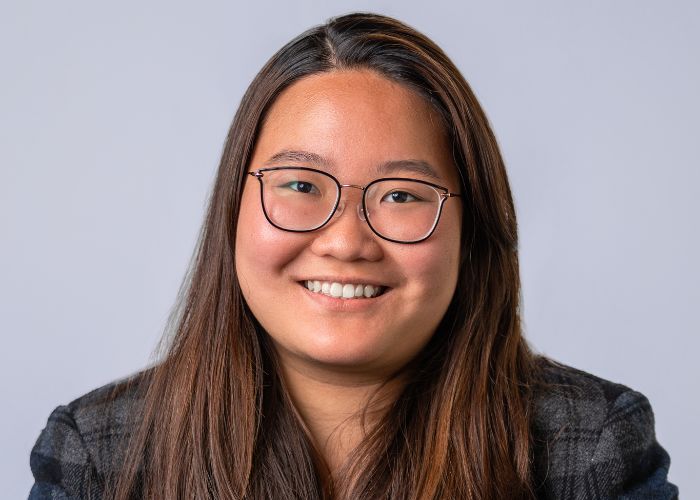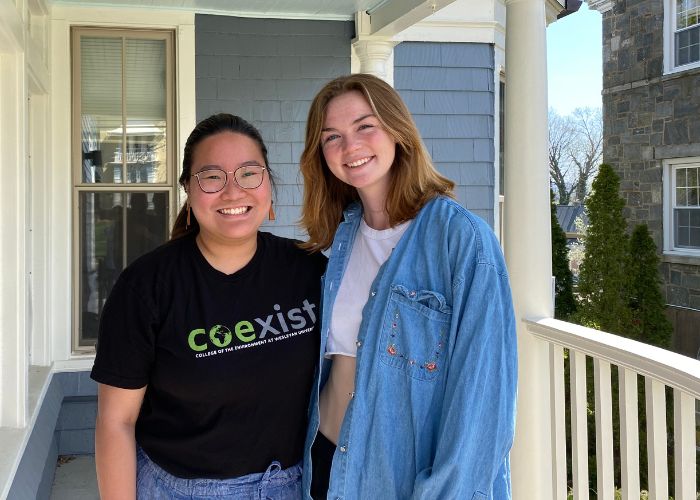
Debbra Goh ‘24 is an environmental studies and region major. She is a Bailey College of the Environment summer fellowship recipient and has utilized this support to work on her senior thesis, which will examine the Orang Laut community in Singapore and national narratives of development. She is also a Bailey COE Think Tank fellow, a member of the Wesleyan Green Fund, and cofounder of WesThrift, Wesleyan’s free thrift store.
Hello Debbra! Would you share a bit about your background, and academic experience so far at Wesleyan?
I grew up in Singapore, an island nation in Southeast Asia. I’m majoring in religion and environmental studies. I always knew that I wanted to major in environmental studies, but religion was really a surprising major for me. I took a class freshman year because it sounded interesting, and then just realized it was something that I was very interested in. I see it as a very complementary major to environmental studies, in that the religion department takes a very human and community centric approach toward thinking about the world. I thought that it could provide me a very niche lens through which I could examine the world, how societies are created, and how these influences impact behavior and action. In combination with environmental studies, I can examine how these beliefs and value systems that people are brought up with shape the way that they think of and interact with the world around them. There have been amazing faculty mentors who have given support both within the classroom and outside of it.
Last summer you received a Bailey College of the Environment summer fellowship. Would you share what your experience was like and how is it informing your work this semester?
I received a few grants last summer for my thesis research. My senior thesis is going to be in the religion department, and it will have environmental components within it. I’m really thinking about the myths of developmental trajectories in Singapore, and how state policies on economic development and land use have affected the religious practices and traditional knowledge of this indigenous community in Singapore, the Orang Laut.
Last summer I went back to Singapore to do research—speaking to members of the Orang Laut community and learning more about them. I think it was really interesting because there are a lot of young activists who are working to get the stories of this community told. The community is not something that I really knew a lot about growing up.
I think there’s a lot more momentum in learning about the Orang Laut community today than there has been in past years. I think it was a really good time for me to begin this project. When I was speaking to the young activists they were really pushing for acknowledgement and advocacy and education surrounding their communities and the issues that they faced in the past.
I also spent time in the National Libraries and the National Archives, looking at different kinds of data regarding how Singapore society has changed and developed over the past 50 or 60 years. The Orang Laut community exists within the ebb and flow of this development narrative that the country has created.
Would you share a bit of history surrounding the Orang Laut community in Singapore?
Singapore is an archipelagic nation; it is an island nation but also a nation of islands. When people think of modern Singapore, they think of it like the main island where the entire population basically lives today, but in the past the other islands were inhabited. That is where the Orang Laut community lived, on the southern islands. In English, Orang Laut means people of the sea. The islands where they had their settlements were redeveloped for a variety of purposes in the 60s and 70s. They became oil refineries, bases for the petrochemical industry in Singapore, and the site of Singapore’s National Landfill.
When growing up in Singapore, I think the narratives surrounding these developments regarded how important these creations were, and how beneficial they were on a social and economic level to the country. I did not know that these islands used to be inhabited and that there were people who used to call these islands home. There were people who had these deep social, emotional, cultural, and communal relationships to the land and the seas. I think when I found out about this it really sparked an interest in me in learning more about these stories and these communities.
You said that you think that there’s been an uptick in activism among young people regarding the Orang Laut community. Why do you think this is?
I think 2015 marked a turning point, potentially because 2015 was the 50th-year anniversary of Singapore’s independence.There was a lot more interest in looking back and thinking about how far we have come as an independent nation and looking at the people who have shaped our history. Younger descendents of the Orang Laut community began looking at their family pasts. From 2015 onward, there was also more grant funding and support from the Singapore government to preserve cultural heritage. As more and more people start speaking up about these issues within the community there continues to grow a greater sense of potential and excitement.
You were also one of the speakers at the Where on Earth event, what was that experience like?
I am one of the Bailey College of the Environment’s Think Tank student fellows. Ella Doherty ‘24, another Think Tank fellow, and I were both involved with planning the Where on Earth symposium. We thought it would be interesting to have a space for students to share their thoughts regarding the major climate issues people are thinking about. We presented a youth perspective on what the future looks like, and presented both optimistic and pessimistic futures. Then, we opened up the conversation to interact with the audience and learn more about what they were considering. There were many parents who were here for parents’ weekend and we were able to have an intergenerational dialogue to learn more about what different generations were thinking.
What kind of work do you do as a Think Tank fellow?
The Bailey COE Think Tank is one of the most exciting opportunities that exists at Wesleyan! There are three professors and an external fellow on the Think Tank along with several students, and its purpose is to create a space for exploration and engagement.
All of us are working on different projects: the professors have their own projects that they’re working on and Ella and I are both working on our thesis and capstone projects, too. It’s a place to workshop our ideas and get different perspectives from an interdisciplinary group. Everyone comes to it from a very different perspective and a different academic background. It is one of my favorite parts of the Bailey College of the Environment.
You are the founder of WesThrift, Wesleyan’s free thrift store! How did you come up with this idea?
At the point when Annie Volker ‘24 and I founded WesThrift, I had been working in the sustainability office, in a variety of positions during my sophomore year. At the end of that year I worked for WasteNot, an annual end of semester move out garage sale. WasteNot did not have the capacity at the time to deal with clothing waste, and I was struck by the amount of waste that was generated on campus from the move in/move out process.
I thought that there was potential for creating a better management system for clothing waste on campus, and so I worked with people in the sustainability office and in the Bailey COE to create a new space. It is an entirely free thrift store and we collect donations from students, staff, and faculty members to create a circular system in which we are able to capture a lot more waste on campus. Last year we saved about 2,300 clothing items that we recirculated. I think that it added up to about a thousand pounds of clothing! This year looks like we are going to do even better than that.

What has your experience been like working on the Wesleyan Green Fund?
I’ve been on the Green Fund since my freshman year, and it’s one of the coolest opportunities that exists on campus, both in terms of being a member and also in terms of having it as a resource for everyone on campus. The Green Fund is an entirely student-led committee that manages $90,000, and what we do is receive proposals throughout the year, by various students, faculty, and staff members who are proposing projects that help support environmentalism in all its varied forms.
Why have you chosen to become so involved with the Bailey College of Environment?
I think that environmental challenges will be the defining problem of our generation. You can either be part of the problem or part of the solution. I always knew that I wanted to work towards creating a more sustainable, equitable, and just future for everyone. That was what drew me into the environmental studies community to begin with. From an academic major standpoint, I think it makes a lot of sense, because I have always been more drawn to the social sciences, which environmental studies incorporates. It is also a linked major, which creates a lot more interdisciplinary potential for problem solving. I think that’s what we need moving forward into the future: realizing environmental issues don’t exist in a silo, but really are connected to every other issue. I don’t think you can solve any environmental problem without drawing upon other disciplines and other fields of study and fields of work.
Is there anything else you would like to share with our coexist community or any advice for other students with similar interests?
I think that firstly I want to express my gratitude towards how supportive the Bailey COE has been over the past couple of years, both from an academic standpoint and also in terms of grant funding to allow these projects to get off the ground. I am also thankful for the community of care it has created. I think that is something that really cannot be understated. I would specifically like to highlight the support of Laurie Kenney from the Bailey College of the Environment and Jen Kleindienst, Wesleyan’s sustainability director! I am very grateful for how generous everyone has been with their time and energy over the past several years.
I think there are a lot of ways to get involved on campus in a lot of different areas. I’ve learned over the past four years that it can be very intimidating to get started, but extracurricular activities can really be the best way to learn more about issues and to get involved.
Wesleyan has been a really amazing space where there is a lot of potential for ideas to become implemented into practice. I think I would encourage students who have cool ideas to use Wesleyan as a sandbox for transforming these ideas into reality. I think that experimentation and creativity is how we can create change makers in the future.